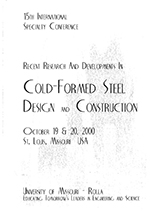Session Dates
19 Oct 2000
Abstract
This paper describes a series of compression tests on cold-formed equal angles with slender cross-section. The angles were tested between pinned ends and loaded axially with eccentric load which caused bending parallel with a leg. The test data are compared with the design rules of the Australian and American specifications for cold-formed and hot-rolled steel structures, as well as the ASCE Standard for the Design of Latticed Steel Transmission Structures. The rules of the specifications for cold-formed steel structures (AS/NZS4600 and AlSI) are shown to be very conservative. The cause of the conservatism is explained and improved design rules are proposed.
Department(s)
Civil, Architectural and Environmental Engineering
Research Center/Lab(s)
Wei-Wen Yu Center for Cold-Formed Steel Structures
Meeting Name
15th International Specialty Conference on Cold-Formed Steel Structures
Publisher
University of Missouri--Rolla
Document Version
Final Version
Rights
© 2000 University of Missouri--Rolla, All rights reserved.
Document Type
Article - Conference proceedings
File Type
text
Language
English
Recommended Citation
Popovic, Dan; Rasmussen, Kim J. R.; and Hancock, Gregory J., "Compression Tests on Cold-formed Angles Loaded Parallel with a Leg" (2000). CCFSS Proceedings of International Specialty Conference on Cold-Formed Steel Structures (1971 - 2018). 1.
https://scholarsmine.mst.edu/isccss/15iccfss/15iccfss-session4/1
Compression Tests on Cold-formed Angles Loaded Parallel with a Leg
This paper describes a series of compression tests on cold-formed equal angles with slender cross-section. The angles were tested between pinned ends and loaded axially with eccentric load which caused bending parallel with a leg. The test data are compared with the design rules of the Australian and American specifications for cold-formed and hot-rolled steel structures, as well as the ASCE Standard for the Design of Latticed Steel Transmission Structures. The rules of the specifications for cold-formed steel structures (AS/NZS4600 and AlSI) are shown to be very conservative. The cause of the conservatism is explained and improved design rules are proposed.



